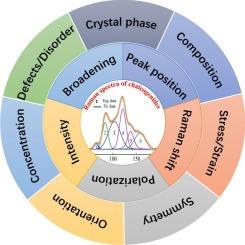硫系相变材料的拉曼散射光谱研究
IF 4.6
3区 材料科学
Q2 MATERIALS SCIENCE, MULTIDISCIPLINARY
引用次数: 0
摘要
硫系相变材料作为数据存储器件的重要组成部分,由于其优异的相变性能,近年来受到了广泛的关注。拉曼散射光谱已被广泛应用于硫化物的相变过程探测。为了更深入地研究硫族化合物的性质,研究人员可以调节实验变量,包括激光功率、元素掺杂水平、样品厚度、偏振光特性和温度。将这种方法与其他实验和理论技术相结合,可以促进对硫系材料更深刻的理解。我们的目的是通过分析不同外部条件下硫族化合物的拉曼散射光谱,对其晶格动力学和声子色散有一个全面的认识。此外,还提出了阻碍硫系相变材料拉曼光谱研究发展的一些障碍。本文可为开发更高效、更精密的存储材料提供宝贵的见解和方向。本文章由计算机程序翻译,如有差异,请以英文原文为准。

Raman scattering spectroscopy study on chalcogenide phase-change materials
Chalcogenide-based phase-change materials, functioning as the crucial constituents of data memory devices, have attracted extensive attention in recent years due to their outstanding phase-change properties. Raman scattering spectroscopy has been extensively utilized to probe the phase change process in chalcogenides. To delve deeper into the properties of chalcogenides, researchers can modulate experimental variables, including laser power, element doping levels, sample thickness, polarized light characteristics, and temperature. Combining this approach with other experimental and theoretical techniques can foster a more profound comprehension of chalcogenide materials. Our aim is to offer a comprehensive understanding of lattice dynamics and phonon dispersion of chalcogenides by analyzing the Raman scattering spectra under different external conditions. In addition, some obstacles hindering the researches and developments in the study of Raman spectroscopy of chalcogenide phase-change materials are proposed. The article could provide invaluable insights and directions for facilitating the development of more efficient and sophisticated storage materials.
求助全文
通过发布文献求助,成功后即可免费获取论文全文。
去求助
来源期刊

Materials Science and Engineering: B
工程技术-材料科学:综合
CiteScore
5.60
自引率
2.80%
发文量
481
审稿时长
3.5 months
期刊介绍:
The journal provides an international medium for the publication of theoretical and experimental studies and reviews related to the electronic, electrochemical, ionic, magnetic, optical, and biosensing properties of solid state materials in bulk, thin film and particulate forms. Papers dealing with synthesis, processing, characterization, structure, physical properties and computational aspects of nano-crystalline, crystalline, amorphous and glassy forms of ceramics, semiconductors, layered insertion compounds, low-dimensional compounds and systems, fast-ion conductors, polymers and dielectrics are viewed as suitable for publication. Articles focused on nano-structured aspects of these advanced solid-state materials will also be considered suitable.
 求助内容:
求助内容: 应助结果提醒方式:
应助结果提醒方式:


